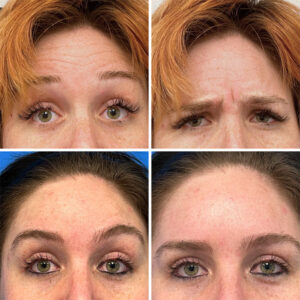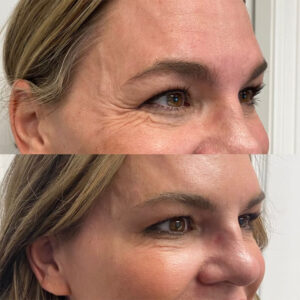Botox and Dysport are both popular injectable treatments that fall under the category of neurotoxins. These neurotoxins are derived from botulinum toxin type A, also known as onabotulinumtoxinA. They work by blocking the release of a neurotransmitter called acetylcholine which is responsible for muscle contraction. By blocking the release of acetylcholine, the muscles relax. This muscle relaxation reduces the appearance of fine lines and wrinkles. Although both products work similarly, they do have some differences in formulation and characteristics.
BOTOX
Botox is a brand name for botulinum toxin type A distributed by Allergan.
Onset & Duration: Results typically begin to appear within 3-7 days and the complete results are visible after 14 days. The effects can last 3-4 months.
Spread: Botox has a relatively limited diffusion, meaning it stays more localized to the injection site. This can be beneficial for targeting specific areas.
Protein Complex: Botox has a higher molecular weight and consists of a complex of proteins that may make it slightly less prone to spreading beyond the injection site.
DYSPORT
Dysport is a brand name for botulinum toxin type A distributed by Galderma
Onset & Duration: Results typically begin to appear within 2-5 days and the complete results are visible after 10 days. The effects can last 3-4 months.
Spread: Dysport tends to diffuse more widely from the injection site, which can be advantageous for treating larger areas like the forehead.
Protein Complex: Dysport has a different protein complex with a lower molecular weight, which might contribute to its broader diffusion.


There are additional factors to consider when choosing between Botox and Dysport. Some practices price neurotoxins differently but this can vary significantly depending on provider and location. Also, while both are effective, individual responses can vary. Some people may find that they prefer one over the other based on how their body responds to the injection. .
Ultimately, the choice between Botox and Dysport may come down to personal preference and the specific needs of the treatment area. Consulting with a qualified practitioner will help determine which option is best for achieving your desired results.



